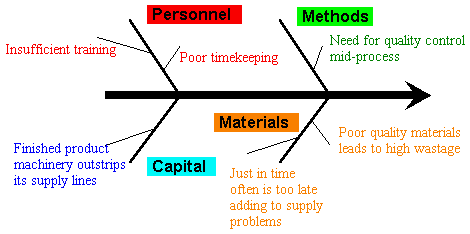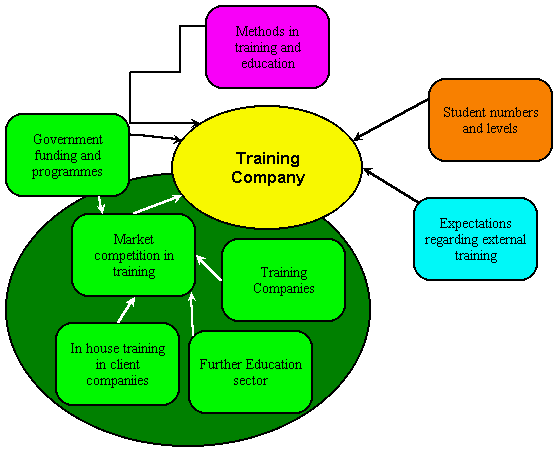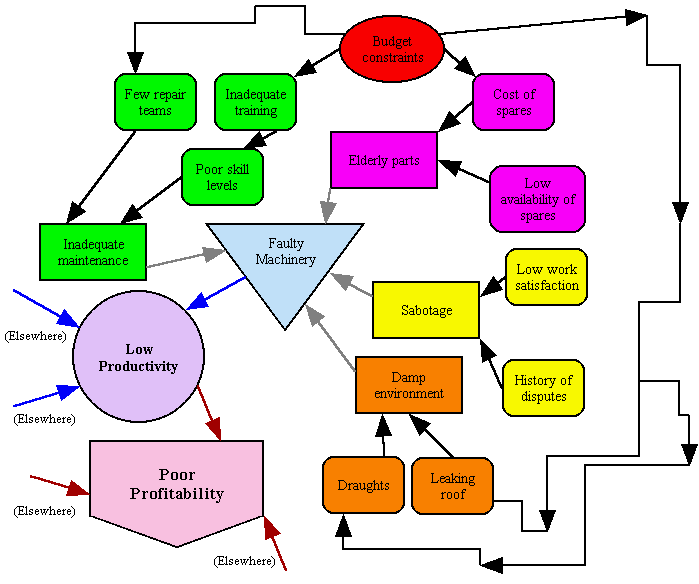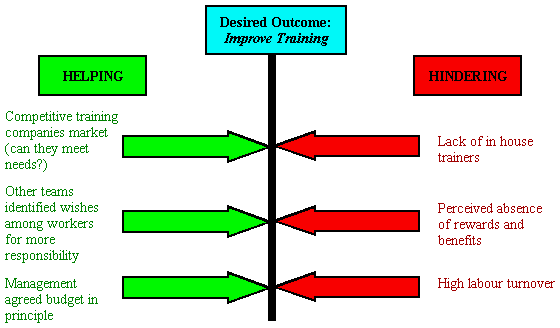Project teams are set up to look at specific problems or at least problems to solve in certain areas. They usually cross though the standard lines of management authority and add to its effectiveness. They create a structure where the line of command in effect follows on from problems to be solved. When workers are involved in more spontaneous but very effective groups, it means a greater sense of ownership across the board and less supervision.
Many projects arise, which are simple to complex, where insight about how to improve matters can increase efficiency. Workers can show they know their work and environment, and it puts them into a positive attitude regarding work areas (and means industrial disputes are less likely). A team spirit is generated as discussion and analysis leads to problem solving and people come to collective decisions. Specialist teams appointed by management should gain respect if the right people are chosen and they seem to be dedicated to enhancing the overall objectives of an organisation.
People who "go in" find out about areas of work not always within immediate experience, so there is an element of training on the job. The teams look at staff operations and more and extend the discussion and analysis, so that in effect all staff become problem identifiers and solvers.
Sometimes teams have wider specialist insights and cover more broad and complex but still practicable tasks. Whichever they are, they all benefit from thorough and good analytical methods as well as existing knowledge and insights.
Still, not all findings and programmes that result are pleasant for everyone, but perhaps information is spread and understanding is gained. Rational findings and involvement are both crucial.
The teams have two kinds, mainly. The first is quality groups and the second improvement teams both of which have their own distincitve features and share features.
|
Quality groups (Workers and their own area)
|
|
Self appointed by volunteers:
|
- Staff come and staff leave according to their own wishes
- A co-ordinator is chosen from amongst the membership
- Time is given to staff for involvement in meetings and investigations
- The aim must be that all staff eventually attend and work in such a group to maximise involvement and commitment
|
|
Members from one department:
|
- This is so that the focus stays specific
- People either already know each other or it is an opportunity to learn about and work with colleagues
- A better departmental spirit is encouraged
|
|
Look into own department:
|
- Staff should be or become familiar with their operating environment
|
|
Discover where problems are:
|
- The group finds problems to tackle and it can decide these
- Some may be too big or require external action and so needs management planning
|
|
Tackle problems within the department:
|
- It should give the opportunity to understand the department more holistically but keep this as the focus
|
|
Types of problems:
|
- Problems may be long standing
- Problems can be new and arising
- Problems have practical solutions
|
|
Examples of problems:
|
- Canteen delays
- Component life
- Punctuality
- Focus and concentration
- Gender variations
- Working relationships
- Lighting
- Noise Pollution
- Buildings and decor
- Production problems identified
- Suggestion Box matters
- Departmental communication
|
|
Practical solutions:
|
- The groups are accountable in terms of what they do in practical terms to solve problems
- The groups are not simply discussion areas alone
|
|
Practical methods:
|
- Initial organising
- Aims
- Objectives
- Early thoughts on analytical methods
- Assessment methods (did change occur?)
- Teamwork generated
- Measurements and objectivity recommended
- Analytical methods vital (training possible, see below)
- Benchmarks discussed
- Briefings and reporting to management required
- Final Report production
|
|
Barred
|
- Pay
- Contractual conditions
|
|
Management must know:
|
- What problems are being identified
- Oversee (hands off style) the carrying out of analysis and solutions
- In case of intervention in case cross department matters are concerned
- To provide the means to solve the problem where extra resources are necessary
- If problem solving cannot be implemented
- In case it blocks a solution (clear reasons should be given)
|
|
Recognition of results:
|
- Groups are given recognition for achievements within the company (although there is usually no bonus for attendance itself)
|
|
Time to finish:
|
- As groups take people out from other work, members should have a time to disband and resume normal working
- Other groups can then form and may tackle the same issue with a fresh view (not ignoring previous attempts)
|
|
Improvement Teams (management innovations)
|
|
Team selection:
|
- The management have taken on tackling deeper or more widespread problems via its team
- Team is appointed by management
- People are those that management know can make a difference
- Management looks for a collection of skills
|
|
Leadership:
|
- The leader or co-ordinator may be chosen by management
- The leader or co-ordinator may be chosen by the team
- Selection:
|
|
Tackle issues which run across departments:
|
- Recruitment is from different departments for a wider range of skills and experience
- The problem is across departments and may be company wide
|
|
Depth of problems:
|
- Complex Deep
- Not have obvious solutions
- Nevertheless problems must not overwhelm (for then more formal systems are needed)
|
|
Examples of problems for improvement:
|
- Customer contacts
- Supplier links
- Widespread costs (a programme of change)
- Sales and output to communicate better
- Management Information Systems (MIS)
- Recruitment standards and systems
|
|
Types of start ups:
|
- Products may need development
- Output lines (of many kinds) may need replacing/ replenishing
|
|
Practical methods:
|
- Aims, objectives and assessment methodology necessary
- Responsibilities handed out within and teamwork generated
- Auditing useful
- Measurements and objectivity recommended
- Detailed and connected analytical methods recommended (training possible)
- Benchmarks to set standards
- Timetabling
- Briefings and reporting back required
- Appropriate report format agreement needed and informing management
|
|
Time of Teams:
|
- The team should have a flexible timetable of tackling the problem The team should have a time to disband
|
|
Management feedback:
|
- Formal progress reports need to go to management
- Management retain directional control where necessary
- Results should be published organisation wide
- Management should adopt changes
- If changes recommended cannot be adopted, management must give clear reasons why not
|
Certain methods and qualities should exist with all teams
The Team Itself (Internal dynamics)
However selected, teams are best effective when:
- There are around five to seven members each
- The people have shown good interpersonal skills (and these can be learnt)
- People can offer functional skills (and these can be learnt)
- People are flexible and can adjust to serve the team
Working on team tasks needs:
- Clear definition
- Goals clearly set out
- Challenging work
- A Co-ordinator, Enabler or Team Leader
- A Secretary (agenda, minutes, reports)
- Possibly a Treasurer
To get definition and goals a constitution is necessary:
- It gives a framework for activity
- It describes for members inside it and outside the principles, benchmarks and procedures
- Everyone in the team participates in this initial task
- They understand budget constraints
- They discuss the time frame
- They know who the important people affected are such as:
- Other workers
- Managers
- Customers
- Buyers
- Suppliers
All teams need:
- Settling in time (while the aim, objectives and constitution are being discussed)
- Development and growth
- Support (from management and workers)
- Understanding (from management and workers)
- Recognition (from management and workers)
Each team meeting should have:
- Timetabling with convenience
- Convenient location
- Appropriate length
- As many as possible attending each time
- Agendas circulated agreed previously
- A realisable purpose (aim)
- Its own objectives for the aim
- Accurate minutes taken
- Good co-ordination
- Worthwhile contributions from everyone
Good team members:
- Self-motivate
- Have and use the right functional skills
- Communicate well
- Contribute well
- Work co-operatively with each other
- Focus on the team
- Do not trivialise other people's contributions
- Do not factionalise
- Do not put personal ambition over team objectives
- Cope with conflict
- Build and support team morale and harmony
- Do not "switch off"
- Do not avoid taking declared risks
- Enjoy success
Each group needs to function with internal:
- Loyalty to each other and the team as a whole
- Time with each other and knowledge (possible outside team building activities too)
- Constructive only conflict
- Tolerance
- Co-operation
- Collaboration
- Trust
- Empowerment
- A sense of shared ownership of outcomes
Full communication makes a team and includes:
- Words
- Body language:
- Gestures
- Posture
- Facial expressions
- Understanding all aspects
- Speaking one at a time
- Speaking clearly
- Speaking economically
- Active listening
- Questioning when necessary
- Answering
Not all teams function well at all times and problems can arise because of:
- An ill defined constitution and set of objectives
- A lack of management support and contact
- Indifference amonst those who will be affected by team decisions
- Absence of necessary skills (train, co-opt or consult management)
- Putting personal goals above the team's
Being a Team Co-ordinator is assisted by:
- Position
- Expertise
- Some charisma
- Connections
- Access to rewards
- Access to penalties
Leadership depends on:
- The nature of the task
- Whether appointed or self selected
- The culture of the organisation as a whole
- Team skills and experiences
- Preferences for leadership style
- Communication of listening and talking
The Co-ordinator should:
- Focus straight away on getting the aim, objectives and constitution sorted out and well
- Get everyone involved
- Organising complementary (to the team) tasks for each individual
- Advise, guide and encourage
- Develop harmonious atmosphere
- Work on disagreements
- Represent to management and argue for more resourcing where necessary
- Acknowledge good work
The Team Task (Activity of the group including analysis)
Difficulties to be tackled by (part 1):
- Definition first of key concerns
- Identifying causes
- Arranging causes in lists and diagrams
It is necessary to know what the problems are in some detail:
- Start with hunches, guesses and internal knowledge within the team about problems and their nature
- Data collection is necessary to have somewhat valid, reliable information for plans of analysis gained through:
- Interviewing workers and supervision staff (there may be a need for anonymity)
- Questionnaires where unambiguous questions are to the point and have quantifiable results
- Internal team knowledge, writing down and combining their assessments of situations
- Departmental and across departmental meetings
- Presentations with responses
- Email and Intranet contact and information gathering
- Drawing on available market research, research and development, some financial data and technical information
- Bringing in specialists and managers for details on matters
- The material gathered has to be presented within the team in an orderly presentable fashion
- It is a matter of judgment whether the team wishes to share this data at this stage outside, or wait until it is combined with methods of analysis and suggested action
- The data is only as good as the methodology combined with it and solutions
There are a whole variety of methods for using data in task analysis and implementations, the analysis which ends in word lists scattered, in columns or in diagrams:
- Brainstorming generates many ideas before a critical assessment of them
- Nominal groups is a method of solution finding:
- Everyone writes their own list of potential solutions
- Everyone speaks a potential solution
- The facilitator writes each on to a flip chart or wipeboard without recording who said it and without evaluating
- Then there is discussion with clarification on them
- Then there is grouping and retitling the grouped, only with each owner's consent
- Then each individual writes down their own top five
- The lists are handed to the facilitator
- The facilitator works out the top five from the lists
- The composite list is written on the flip chart or wipeboard
- There is discussion on the best of the five
- There is a vote on which potential solution is most likely to be used
- What (is being done), Where (from and to environments), When (timescale), Who (cause and affected), How (methods) and Why (purpose at different levels) Analysis systematically breaks a situation down into its component parts or factors
- Cause and Effect or Fishbone diagrams position the difficulties to tackle and should show all causal problems:

- Influence Diagrams work out the relationship between influences and a situation:

- Multiple Cause Diagrams show more complex cause and effect chains than influence diagrams:

- Force Field Analysis identifies many forces promoting and preventing change, essentially two columns:

- Flow Charts or Process Mapping show the order of decisions (start, question, yes, no, task, back loops, stop):

- The 80/20 Technique (80% of problems come from 20% of locations) or Pareto Analysis (the claim that there is a vital few and a trivial many seen across the board in many fields of activity) is able to locate most concentrated causes of difficulties
(Baguley, 2002, 89-101)
Difficulties to be tackled (part 2):
- Finding and analysing possible solutions to listed/ diagrammatic causes
- This may mean:
- Removal of blockages
- Active interventions with new inputs
- Selecting one possibility
- Trialling and testing that possibility
- If not successful, trialling and testing another possibility
- Implementing the solution
- Gaining feedback and reviewing
- Modifying
- At any stage of trialling and implementation, needing management authority, resources and action
Workforce motivation must be understood in that employees:
- Do not just work for the money
- Prefer meaningful targets that are challenging
- Want to solve blockages and difficulties to their work flow
- Want a sense of achievement
- Have potential
- Can handle responsibility
- Have psychological, social and welfare needs and requirements through a large part of their waking time
This means that both the implementation and the resultant effect should, if possible, enhance the higher work motivations of staff. No solution is ever complete. If improvement leads to more project teams seeking even extra improvement, and more involvement, then so much the better. Focus should always be on ongoing financial arrangement, supply line security and cost, efficiency in output (whether service or manufacture), and customer requirements.
Bibliography
Baguley, P. (2002), Teams and Team-Working, Teach Yourself series, London: Teach Yourself Books, Hodder Headline, 170-177, 89-103.
Sadgrove, K. (1995), Making TQM Work, Better Management Skills series, London: Kogan Page, 75-82
Adrian Worsfold




